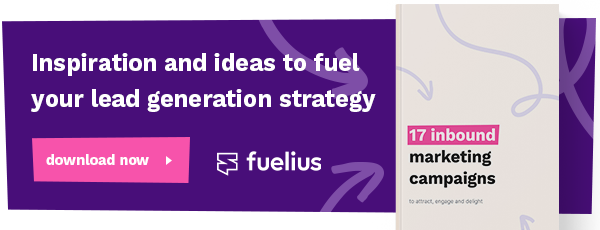
The inbound marketing vs content marketing debate has had plenty of attention – the two terms aren’t interchangeable, and understanding why is a worthwhile exercise. Your own views may need to shift to move your marketing strategy on, so let's dive straight in with a really straightforward analogy...
Simply put, imagine you give a friend a map so they can find their way to a destination. Yes, they can get to the endpoint, but they have to put some effort into planning the route first. Let’s call that map content marketing.
Give the same friend an app that will plan the route for them and tell them when and where to turn – that’s inbound.
- What's in a name?
- Tactical or strategic?
- What's in the toolbox?
- Creativity vs structure
- Achieving the end action
- Final thoughts
What's in a name?
Take a look at how the two terms are explained by their advocates, and there's a clear divergence. The Content Marketing Institute (CMI)’s official definition is that content marketing is:
“...a strategic marketing approach focused on creating and distributing valuable, relevant, and consistent content to attract and retain a clearly defined audience — and, ultimately, to drive profitable customer action.”
The distinct point to grasp here is the distribution aspect – here, the emphasis is on content being pushed out, which could be considered as interruptive. Compare this with the description of inbound marketing given by marketing automation platform HubSpot:
“Inbound marketing is focused on attracting customers through relevant and helpful content and adding value at every stage in your customers’ buying journey. With inbound marketing, potential customers find you through channels like blogs, search engines, and social media.”
With inbound marketing, the focus is on attracting customers in (yes, the clue’s in the name!), rather than reaching them by any means possible. While both approaches have content at their heart and will make your website ‘sticky’, inbound aims to deliver the right message to the right person at the right time by working off the customer’s timetable – the principle being that they should find the content when they want it.
To be clear, inbound marketing tactics certainly include amplifying content to extend its reach through appropriate channels (sharing on social media, for example, as well as via email) – but this is based on careful planning to meet specific campaign criteria.
Tactical or strategic?
Perhaps the simplest way to distinguish between content marketing and inbound marketing is to think about strategy.
Inbound marketing is notable for being extremely structured, with marketing automation at its heart and a huge focus on SMART objectives and measurable outcomes relating to lead generation. With inbound, ROI is key, goals are set from the start and the intention is always to follow a distinct methodology – you can read more about that in our blog post What is Inbound Marketing?
On the other hand, content marketing is a more generic term – objectives may be ‘softer’ and less easy to measure, and there’s no intrinsic reliance on automation using special software. While the CMI states that content marketing is a strategic approach with the ultimate goal of stimulating action, and a specific content marketing campaign may well have clear and measurable targets, content marketing activity can also be ad hoc and more focused on brand awareness and comms objectives than hitting set lead generation targets.
What's in the toolbox?
Another differentiator is the range of tactics used within each approach. Strictly speaking, content marketing can comprise any number of types of material – what happens to that content once it’s been created depends entirely on the preference of whoever’s planned the campaign. In short, there’s no set playbook to follow.
With inbound marketing, content is created according to a structure that drives prospects down a funnel to generate marketing and sales qualified leads. Content is needed at each stage of the funnel, from the top to the bottom. An automated workflow guides individuals from one piece of content to the next and gated content performs the function of capturing data, with the opportunity for progressive profiling to build a more precise picture as the buyer's journey unfolds. Content is mapped to match the buyer as they research their pain point and look for a solution – there's no hard sell and the brand isn't even mentioned until the buyer is approaching the decision stage at the bottom of the funnel.
Creativity vs Structure
While there’s plenty of room for manoeuvre with inbound, it's fair to say that it's more prescriptive than content marketing when it comes to building a campaign – and this is one of its strengths. Certain content formats work better than others at different stages of the buyer's journey, and this structured approach (while keeping the flexibility to test what works best and fine-tune accordingly) makes inbound campaign planning relatively straightforward.
Typically, content marketing homes in primarily on creating great content – it can be ‘all about the idea’ and how to share and deliver measurable ROI from that content is sometimes a secondary consideration. With inbound marketing, tactics are diverse and extend beyond content to take in website design, email marketing, online events and more to join up all the dots. The desired outcome is always front of mind, whether developing content themes, devising the flow of content or improving the customer journey on a website.
Achieving the end action
We’ve already mentioned that content marketing may, or may not, involve inbound tactics. And keeping a website fresh with great content will have SEO benefits, regardless of whether inbound methodology is being used or not. But will your consumer take the desired action, having digested a piece of content? What happens next?
Contrast this with what happens once a buyer’s on an inbound journey. It’s possible to keep serving them with relevant content until they reach their end goal, and this can be done at scale with no additional resource needed until they become a sales-qualified lead, thanks to marketing automation.
Final thoughts
It’s generally accepted that content marketing is, in fact, a subset of inbound marketing – think of it as the nectar in the centre of the flower. Inbound marketing provides the whole delivery mechanism. If you’re already practising content marketing, the natural next step is to make that content work harder by progressing to a full inbound approach.
> Download our beginner's guide to inbound leads <
Header image source: Unsplash





